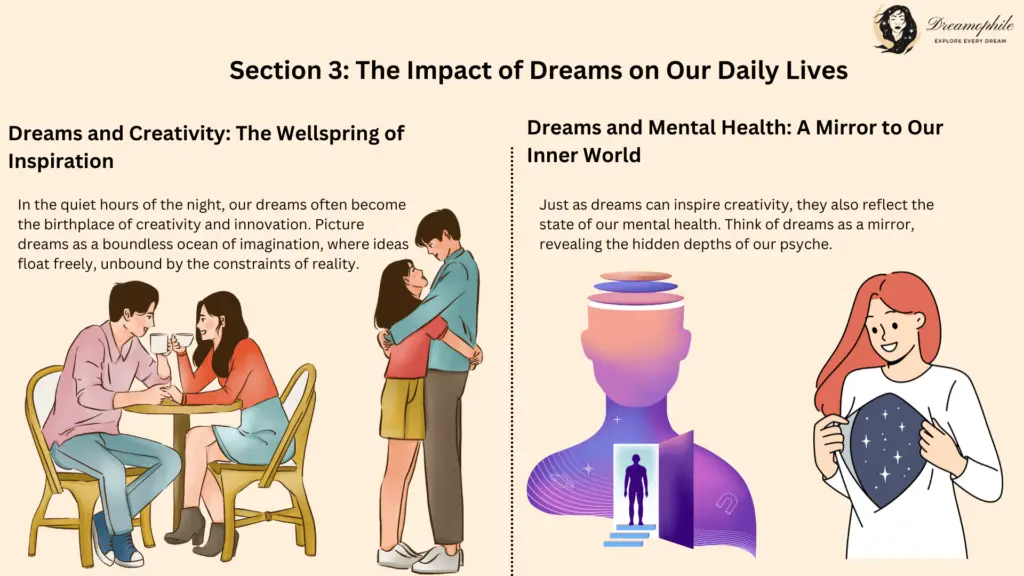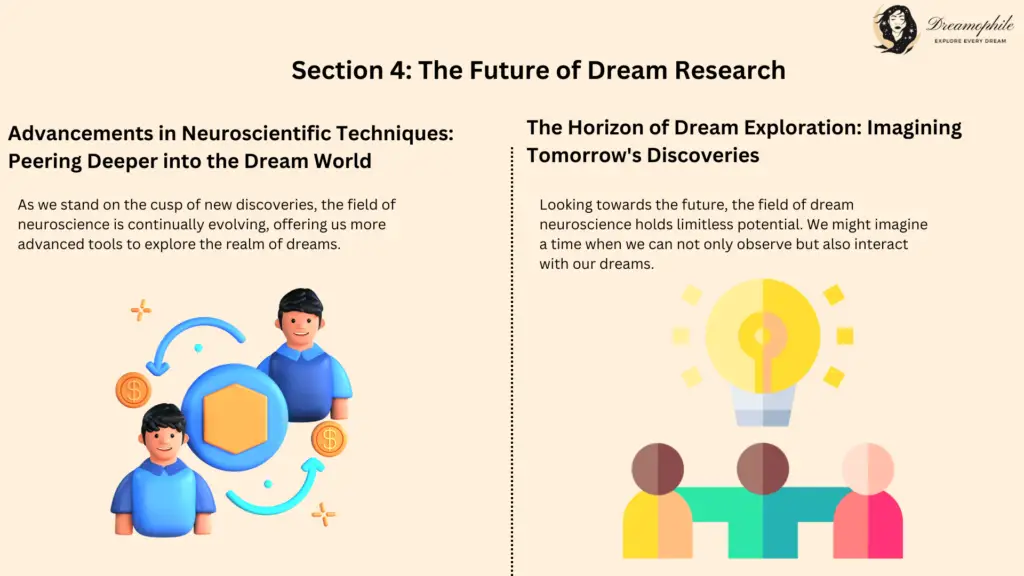Introduction
A Dreamy Beginning
Imagine each night as we close our eyes, we embark on a voyage, not across oceans or continents, but into the uncharted territories of our own minds. Here, in the quiet darkness, dreams unfold like a tapestry woven from the threads of our thoughts, feelings, and memories. Dreams are the mind’s own storytelling time, a nightly performance in the theater of our subconscious. They are like a hidden treasure chest, brimming with mysterious jewels and untold stories, waiting to be discovered and understood.
These dreamscapes are more than just random flickers of imagination; they are a mirror reflecting the depths of our psyche. Each dream is a unique piece of art, painted with the colors of our emotions and experiences. As we wander through these dream worlds, we embark on a journey that is both deeply personal and universally shared, a journey into the very essence of being human.
The Wonder of Neuroscience
Enter the realm of neuroscience, where scientists, like skilled navigators, chart the course of these nocturnal journeys. Neuroscience is the compass that helps us navigate the complex landscape of the dreaming brain. It unlocks the secrets hidden in the folds of our brain matter, revealing how and why we dream. Through the lens of neuroscience, dreams transform from mystical riddles to windows of understanding, offering insights into the workings of our minds.
Neuroscience does not just uncover the mechanics of dreaming; it illuminates the connection between our dreams and our waking lives. It shows us how dreams are intertwined with our memory, our creativity, and our emotional well-being. In understanding the neuroscience of dreams, we begin to understand more about ourselves, opening up new possibilities for healing, growth, and self-discovery.
Section 1: The Neuroscience of Dreams
The Brain’s Nighttime Journey
As we drift into sleep each night, our brain embarks on a remarkable journey. Picture it like a city that never sleeps, where different neighborhoods (parts of the brain) light up in a sequence, each playing a specific role in the drama of our dreams. Initially, as we ease into sleep, the brain waves begin to slow down, signaling the transition from the wakeful bustle to the tranquil realms of slumber.
During the dreaming phases, primarily in the REM (Rapid Eye Movement) stage, the brain becomes a hub of activity. It’s almost as if, in our deepest sleep, our brain is wide awake. This stage of sleep is marked by rapid eye movements as if our eyes are following the scenes of our dreams. The brain during REM sleep is a lively storyteller, creating vivid, often emotionally charged stories. These tales are not just random; they are intricately woven from the fabric of our memories, fears, and desires.
Dreaming and Brain Regions
In this nocturnal tale, different regions of the brain play starring roles:
- The Amygdala: This part of the brain, often associated with processing emotions, is particularly active during dreams. Imagine it as the director of an emotional drama, intensifying the feelings in our dreams, from joy to fear.
- The Hippocampus: Central to memory, the hippocampus is like an archivist, pulling out old files and memories, and weaving them into the storyline of our dreams. It’s partly why we might dream of long-forgotten people or places.
- The Prefrontal Cortex: This area, associated with reasoning and planning, dials down its activity in dreams. Think of it as the logical part of the city taking a break, which is why dreams often defy logic and reality.
- The Visual Cortex: Involved in processing visual information, this region helps create the vivid and often bizarre imagery of our dreams. It’s like the brain’s own movie projector, displaying a montage of images as we sleep.

Section 2: The Language of Dreams in Neuroscience
Decoding Dreams: Unraveling the Mind’s Nighttime Stories
In the mysterious world of dreams, every image, sensation, and emotion is a piece of a puzzle. Neuroscience seeks to be the dream decoder, unraveling the language of our nocturnal narratives. This quest is like learning to read an ancient, mystical script. Scientists delve into the brain’s activity during dreams, trying to connect the dots between what we dream and what those dreams might mean.
Advanced technologies like fMRI (functional Magnetic Resonance Imaging) and EEG (Electroencephalography) are like high-powered microscopes, allowing neuroscientists to peek into the dreaming brain in action. They observe how different brain areas light up, whisper to each other, and orchestrate the dream. By understanding which parts of the brain are active and how they communicate, scientists begin to decode the language of dreams.
This endeavor is not just about satisfying curiosity; it’s a journey to understand our deeper selves. Each dream is a story told in the language of the subconscious, reflecting our fears, desires, and experiences. Decoding this language helps us understand not just what we dream, but why we dream it.
The Connection Between Dreams and Memory: A Dance of Recollection and Emotion
Dreams and memory share a delicate dance in the theater of our minds. During the REM stage of sleep, when most dreaming occurs, our brain is busy sorting through the day’s experiences, deciding what to remember and what to let go. This process is like a nightly rehearsal, where memories are reviewed, reorganized, and sometimes rewritten.
The hippocampus, the brain’s memory center, plays a key role here. It’s like a librarian, carefully cataloging our memories. During dreams, this process becomes more dynamic. Our brain combines fragments of memories, both recent and distant, creating a collage that can be bizarre yet meaningful.

Section 3: The Impact of Dreams on Our Daily Lives
Dreams and Creativity: The Wellspring of Inspiration
In the quiet hours of the night, our dreams often become the birthplace of creativity and innovation. Picture dreams as a boundless ocean of imagination, where ideas float freely, unbound by the constraints of reality. This ocean is rich with unique connections, unexpected solutions, and artistic inspirations.
Many artists, writers, and inventors have drawn from this wellspring. They have captured the ephemeral images and ideas from their dreams and transformed them into masterpieces and breakthroughs in the waking world. Dreams can break down walls between thoughts and concepts that seem unrelated, allowing us to see things in new ways. They provide a playground for the mind, where the rules of logic don’t apply, and the impossible becomes possible.
Neuroscience suggests that this creative boost is due to the brain’s activity during REM sleep, where the barriers between different ideas and memories are more permeable. It’s as if the brain, in its dream state, becomes a skilled artist, mixing colors and shapes in ways it wouldn’t dare to when awake. This blending of thoughts and experiences can spark new ideas, leading to creative problem-solving and innovative thinking.
Dreams and Mental Health: A Mirror to Our Inner World
Just as dreams can inspire creativity, they also reflect the state of our mental health. Think of dreams as a mirror, revealing the hidden depths of our psyche. Patterns in our dreams can offer clues to our inner emotional state, sometimes even before we’re consciously aware of them.
Neuroscience has shown that certain types of dreams can be associated with mental health conditions. For example, frequent nightmares may be linked to anxiety or post-traumatic stress disorder (PTSD). Conversely, dreams can also be a part of the healing process, providing a safe space for the mind to process and work through emotional challenges.
The relationship between dreams and mental health is like a dance, where each influences and informs the other. By paying attention to our dreams, we can gain insights into our emotional well-being. They can be a tool for self-reflection and understanding, guiding us toward a deeper understanding of ourselves and our emotional needs.

Section 4: The Future of Dream Research
Advancements in Neuroscientific Techniques: Peering Deeper into the Dream World
As we stand on the cusp of new discoveries, the field of neuroscience is continually evolving, offering us more advanced tools to explore the realm of dreams. These advancements are like new telescopes, allowing us to gaze deeper into the cosmos of the human mind. Cutting-edge technologies like high-resolution brain imaging and machine learning algorithms are opening doors to understanding dreams like never before.
For instance, newer versions of fMRI and EEG provide more detailed maps of brain activity during sleep, revealing the intricate dance of neurons that gives rise to dreams. Machine learning helps in interpreting these vast amounts of data, finding patterns and connections that were previously invisible. These tools are not just expanding our knowledge but are reshaping our very understanding of dreams.
The Horizon of Dream Exploration: Imagining Tomorrow’s Discoveries
Looking towards the future, the field of dream neuroscience holds limitless potential. We might imagine a time when we can not only observe but also interact with our dreams. Technologies like lucid dreaming induction devices or dream recording might transform our approach to sleep, turning it into an interactive experience.
We could see advancements in dream therapy, using our understanding of dream mechanics to address mental health issues. Imagine being able to ‘tune’ our dreams, using them as a therapeutic tool to heal and grow. The possibility of enhancing learning and creativity through dream manipulation could also become a reality.
Another exciting frontier is the exploration of the connection between dreams and consciousness. Understanding this link could answer some of the most profound questions about the human experience and our perception of reality.

Conclusion
Reflecting on the Mind’s Nighttime Odyssey
As we draw the curtains on our exploration of the enigmatic world of dreams through the lens of neuroscience, we find ourselves enriched with a deeper understanding and appreciation for this nightly odyssey. We’ve journeyed through the brain’s intricate pathways, uncovering the secrets behind the mysterious tapestry of dreams. From the lively dance of neurons during REM sleep to the profound connections between dreaming and our emotional well-being, each discovery has been a step closer to unraveling the mysteries of our minds.
We have seen how dreams are not mere figments of our imagination but vital processes that shape our creativity, problem-solving skills, and mental health. The advancements in neuroscientific techniques have opened new windows into understanding these complex phenomena, revealing the incredible potential of our own subconscious.
A Dream-Inspired Future
As we look towards the future, the continued exploration of dreams holds the promise of not just advancing scientific knowledge but also enriching our everyday lives. Imagine a world where we can harness the power of our dreams to foster creativity, enhance learning, and heal from emotional traumas. The possibilities are as limitless as the dreams themselves.
The journey into the neuroscience of dreams is akin to sailing in uncharted waters, filled with wonder and discovery. Each new finding is a beacon that lights up more of this vast, mysterious ocean, guiding us to a deeper understanding of the human condition. As we continue to navigate these waters, we hold the key to unlocking more of the mind’s hidden treasures.

